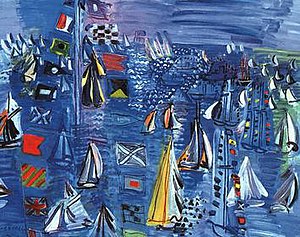From Wikipedia, the free encyclopedia
| Raoul Dufy |
|---|

Le Cavalier arabe (Le Cavalier blanc), 1914, oil on canvas, 66 x 81 cm, Musée d'Art Moderne de la Ville de Paris
|
| Born | 3 June 1877
Le Havre, France |
|---|
| Died | 23 March 1953 (aged 75)
Forcalquier, France |
|---|
| Nationality | French |
|---|
| Education | École nationale supérieure des Beaux-Arts |
|---|
| Known for | Painting, drawing, design, printmaking |
|---|
| Notable work | La Fée Electricité (1937) |
|---|
| Movement | Fauvism, impressionism, modernism, cubism |
|---|
Raoul Dufy (
French: [ʁa.ul dy.fi]; 3 June 1877 – 23 March 1953) was a French
Fauvist painter, brother of
Jean Dufy. He developed a colorful, decorative style that became fashionable for designs of
ceramics and
textiles, as well as decorative schemes for public buildings. He is noted for scenes of open-air social events. He was also a
draftsman,
printmaker, book
illustrator,
scenic designer, a designer of furniture, and a planner of public spaces.
Contents
Biography[edit]
Early life[edit]
Raoul Dufy was born into a large family at
Le Havre, in
Normandy. He left school at the age of fourteen to work in a coffee-importing company. In 1895, when he was 18, he started taking evening classes in art at Le Havre's École des Beaux-Arts (municipal art school). The classes were taught by Charles Lhuillier, who had been, forty years earlier, a student of the French portrait-painter,
Ingres. There, Dufy met
Raimond Lecourt (fr) and
Othon Friesz with whom he later shared a studio in
Montmartre and to whom he remained a lifelong friend. During this period, Dufy painted mostly Norman landscapes in watercolors.
In 1900, after a year of military service, Dufy won a scholarship to the
École nationale supérieure des Beaux-Arts in Paris, where again he crossed paths with Othon Friesz. (He was there when
Georges Braque also was studying.) He concentrated on improving his drawing skills. The
impressionist landscape painters, such as
Claude Monet and
Camille Pissarro, influenced Dufy profoundly. His first exhibition (at the Exhibition of French Artists) took place in 1901. Introduced to
Berthe Weill in 1902, Dufy showed his work in her gallery. Then he exhibited again in 1903 at the Salon des Indépendants. A boost to his confidence: the painter,
Maurice Denis, bought one of his paintings. Dufy continued to paint, often in the vicinity of Le Havre, and, in particular, on the beach at
Sainte-Adresse, made famous by
Eugène Boudin and
Claude Monet. In 1904, with his friend,
Albert Marquet, he worked in
Fecamp on the
English Channel (La Manche).
Later years[edit]
Henri Matisse's
Luxe, Calme et Volupté, which Dufy saw at the Salon des Indépendants in 1905, was a revelation to the young artist, and it directed his interests towards
Fauvism.
Les Fauves (the wild beasts) emphasized bright color and bold contours in their work. Dufy's painting reflected this aesthetic until about 1909, when contact with the work of
Paul Cézanne led him to adopt a somewhat subtler technique. It was not until 1920, however, after he had flirted briefly with yet another style,
cubism, that Dufy developed his own distinctive approach. It involved skeletal structures, arranged with foreshortened perspective, and the use of thin washes of color applied quickly, in a manner that came to be known as
stenographic. Dufy's cheerful oils and watercolors depict events of the time period, including yachting scenes, sparkling views of the
French Riviera, chic parties, and musical events. The optimistic, fashionably decorative, and illustrative nature of much of his work has meant that his output has been less highly valued critically than the works of artists who have addressed a wider range of social concerns.
日本人喜歡 Raoul Dufy (1877~1953)
代表作[編集]
- サンタドレスの浜辺(1906 年)(愛知県美術館)
- 海の女神(1936年)(伊丹市立美術館)
- 電気の精(1937年)(パリ市立近代美術館)長さ60メートル、高さ10メートルの大作
- 三十年、或いは薔薇色の人生(パリ市立近代美術館)
- 小学館ウィークリーブック 週間美術館 ルソー/デュフィ 小学館
- ユーリディス・トリション=ミルサーニ著 太田泰人訳 デュフィ 岩波世界の巨匠 岩波書店
- 島田紀夫 千足伸行編 世界美術大全集 第25集 フォービズムとエコールド・パリ 小学館
- ドラ・ベレス=ティピ著 小倉正史訳 デュフィ作品集 リブロポート
- NHK教育テレビ「新日曜美術館」歓喜の画家 ラウル・デュフィ
- テレビ東京「美の巨人たち」
- NHKサービスセンター「ラウル・デュフィ展 ―美、生きる喜び―」
- 読売新聞社文化事業部「デュフィ展」ポンピドゥーセンター所蔵
The French Fauvist painter Raoul Dufy was born on this day in 1877.
Raoul Dufy
-
Raoul Dufy was a French Fauvist painter. He developed a colorful, decorative style that became fashionable for designs of ceramics and textiles, as well as decorative schemes for public buildings. He is noted for scenes of open-air social events.
Wikipedia
-
-
In 1905, deeply affected by Matisse, Raoul Dufy began a lifelong exploration of color and line. He titled this 1926 picture "The Basket." If you could rename this painting, what would you call it?
Raoul Dufy, "The Basket,” 1926, oil on canvas, National Gallery of Art, Washington, Chester Dale Collection
3 июня 1877 года родился "художник радости" - представитель фовизма Рауль Дюфи. В эрмитажной картине "Парусники в гавани Довиля" (холст, масло, ок. 1936 г.) Дюфи накладывает рисунок на цветовую подкладку – прием, к которому художник прибегал в эскизах для декоративных тканей, он нередко использовал и в живописных произведениях.
Born on this day in 1877 was French Fauvist, 'painter of joy' Raoul Dufy. In his 'Sailing Boats in Deauville Harbor' from the Hermitage collection (oil on canvas, circa 1936) colour surface is overlaid with drawing. Dufy used this method in his decorative textiles sketches and also transferred it to paintings.
|





沒有留言:
張貼留言